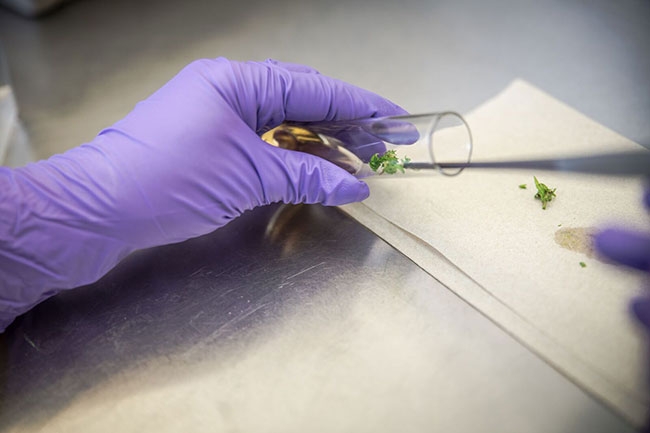
Features
Cannabis
Crops
Propagating into cannabis culture
Tissue culture offers a pest-free propagation environment for cannabis.
August 7, 2018 By Greta Chiu
 Producers can use tissue culture to propagate cannabis in a sterile environment. Front Range Biosciences
Producers can use tissue culture to propagate cannabis in a sterile environment. Front Range BiosciencesFor horticulture, propagation using tissue culture is nothing new. In fact, the technique has been used in crops like lettuce, hops, mint, potato stock, orchids, ornamental plants and berries.
“Tissue culture is the basis for just about every other big ag company,” says Dr. Jon Vaught, CEO and co-founder of Front Range Biosciences (FRB), an agricultural biotech company based in Lafayette, Colorado that specializes in tissue culture propagation of high value crops such as cannabis through its Clean Stock program.
The process involves taking a small cutting from the mother plant, which is then sterilized to remove viruses, fungi and other pathogens before being placed on a gel-like growing medium full of nutrients tailored toward that crop. Multiple plants from the same mother plant can then be propagated quickly using this method – cloned, in other words, and without the need for pesticides.
“You start out with clean, healthy vigorous plants,” says Vaught. “It also allows you to propagate a plant in a pest-free environment. In a laboratory, there are no bugs like thrips or mites or any of the other things that carry nasty diseases and cause crop loss.”
Growing in high-humidity environments such as greenhouses and indoor spaces can drive fungal growth and diseases, such as powdery mildew, encourage bacterial growth, and harbour insect pests that carry harmful viruses.
“All those different diseases can have really dangerous effects,” says Vaught. “We’re going from a small industry to now tens of millions and hundreds of millions of plants that are grown and spread all over the world.” If a biopathogen were to spread globally, it could cripple the industry, he adds.
That’s why Vaught and his team are looking to provide Clean Stock material to LPs internationally, mitigating the risk of a global outbreak. And with the high demand for cannabis plants, tissue culture presents a good solution to large-scale clone production with little to no crop loss or disease.
In Canada though, many of the suppliers are vertically integrated, controlling their own supply chains with their own nurseries. While some continue to clone using traditional methods, others have seen the advantages of propagating through tissue culture.
“This is a major advantage in crops that are clonally propagated, as disease and pathogens can be transferred from generation to generation using those [traditional] propagation techniques, and can cause production issues,” notes Anandia Labs, a licensed cannabis-testing facility in Vancouver, BC. They’ve been using plant tissue culture for cannabis production since receiving their licence in 2016.
Once established, plant tissue culture can also be used as a way of storing different varietal genetics until they’re ready for transfer to cultivation facilities. This is how Anandia stores its collection of more than 350 different genotypes, a kind of genetic “archiving” service they offer to LPs for backing up their proprietary or valuable cultivars.
“While there are a number of advantages to plant tissue culture, the skill and infrastructure required to develop techniques and maintain plants are not trivial,” Anandia adds. “Plant tissue culture is often referred to as an art as much as a science as the technical expertise requires creativity, refinement, flexibility and attention to detail.”
Simply scattering seeds amid a field of corn is no longer an option. From industrial hemp and protein to highly regulated cannabinoid-based drugs, production needs to meet demand.
“The ability to maximize production across all of these different segments and product categories is going to require a lot more than just throwing some seeds in the ground,” says Vaught. “It’s going to require a massive industry that can handle the supply chain. The growth that we’re seeing is massive.”
Print this page